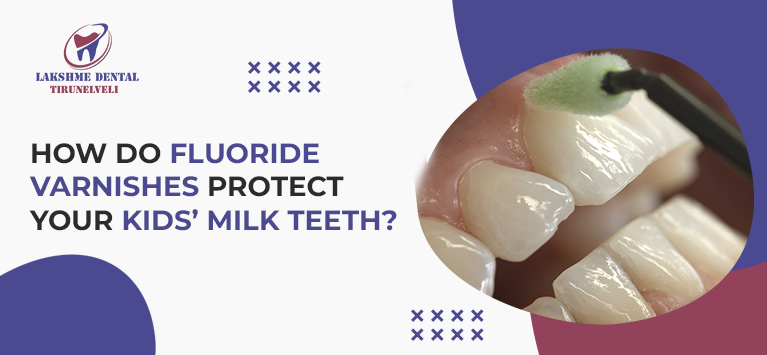
How do fluoride varnishes protect your kids’ milk teeth?
Fluoride Varnish is a kind of topical fluoride therapy. It is a highly concentrated form of fluoride applied over the teeth surfaces of children to prevent bacterial invasion. It has been widely used by pediatric dentists globally as dental caries prevention therapy for decades. Dentists recommend every kid should get fluoride varnish treatment 2 to 4 times per year.
Even though different brands of fluoride varnishes are available in the market, a dentist should perform it since it will be more effective and safe. Even adults can use it to fix non-cavitated lesions on their permanent teeth.
What is the difference between fluoride varnish and fluoride gel?
Even though both products tend to strengthen the teeth enamel and protect our teeth from cavities, their active ingredients and therapeutic procedures vary.
The fluoride gels contain a mixture of fluoride (12,300 ppm F), hydrofluoric acid and orthophosphoric acid, whereas the varnish is a resin-based substance containing fluoride (22,600 ppm F).
It indicates that fluoride varnishes can adhere over the teeth surfaces longer than gels and interact with the hard tissues of a tooth efficiently. Researchers also found that fluoride varnishes are more efficacious in preventing cavities than fluoride gels.
Generally, fluoride treatment is provided as a gel using personalized trays. However, they are quite messy, and patients also feel uncomfortable. On the contrary, fluoride varnishes can be applied directly over the teeth and don’t pose any problems for patients.
What is involved in fluoride varnish treatment?
Fluoride varnish application is a simple process and can be done in a few minutes. The steps involved in this preventative care treatment are as follows:
1) Baby should be placed on parent’s lap with head resting on parent’s knees.
2) The parent is placed knee-to-knee position with the dentist.
3) Keep the child’s mouth open and dry his/her teeth with gauze.
4) Apply fluoride varnish on all surfaces of each tooth with a brush.
The fluoride is sticky, so it can harden quickly when it comes in contact with saliva. It means the procedure will be completed in a single dental visit.
What are the advantages and disadvantages of using fluoride varnish?
Fluoride varnishes have several advantages over other types of fluoride used in dentistry. Here are a few:
- The fluoride varnishes taste better than gels, so patients of all ages do not feel uncomfortable with this topical fluoride application.
- The risk of ingesting fluoride is minimal because dentists use just a small amount of fluoride varnish.
- Fluoride varnish application does not need plastic trays, so it is appropriate for gag reflex patients.
- The adhesive consistency of fluoride varnishes makes them stay for several hours on your teeth.
- As seen earlier, fluoride varnishes have high concentrations of fluoride. Hence they can strengthen the enamel effectively more than gels and foams.
Even though fluoride varnishes are highly effective than other kinds of fluoride therapy, they have some limitations as follows:
- Few patients might have nausea after applying the topical fluoride to their teeth.
- It makes the teeth appear yellowish for a few days after the treatment. Later the discoloration fades with regular brushing.
How should you care for your kids’ milk teeth after fluoride varnish application?
The effectiveness of fluoride varnish on teeth relies on how long they stay on the teeth. So it is mandatory to follow the fluoride varnish instructions suggested by your dentist following the treatment.
Following are the aftercare suggestions we give to our patients after applying fluoride varnish:
- Take soft foods for the rest of the day
- Don’t brush or floss until the next day
- Don’t rinse your mouth with mouthwashes for at least 6 hours after fluoride varnish application.
- Don’t consume hot drinks, cold drinks, and alcohol for 6 to 8 hours following the treatment.
Bottom line
Fluoride varnish is the most common preventative care provided by pediatric dentists. Even though it cannot prevent cavities completely, it can halt the progression of infection deep inside a tooth to a great extent.
Aside from preventing cavities, fluoride varnishes have various therapeutic benefits, like desensitizing the unveiled surfaces of a tooth root, fluoride application around dental braces, avert root dentin lesions, and much more.










